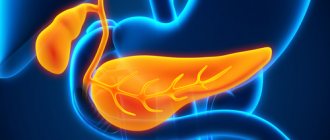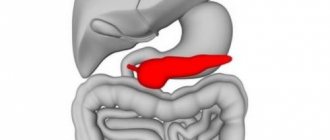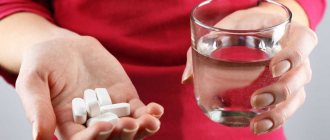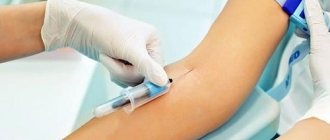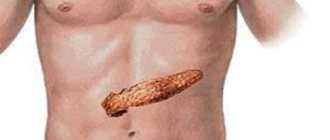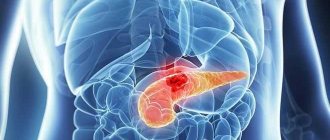Pancreatitis is one of the most common diseases of the pancreas, which develops due to severe inflammation of this organ. Pancreatitis manifests itself in different ways, depending on the degree of neglect and the form of its occurrence. Let's take a closer look at the causes and symptoms of pancreatitis, how to treat it at home, what you can and cannot eat with this disease, and much more.
Causes
Inflammation of the pancreas can occur for the following reasons:
- Severe intoxication of the body due to poisoning with chemicals or medications.
Important! You can be poisoned by medications if you take them without a doctor's prescription. However, the situation will become even more complicated if a person takes the wrong dose of the drug.
- Alcohol abuse overloads the pancreas, which leads to the gradual formation of pancreatitis.
- Various diseases of the gallbladder and bile ducts. In this condition, the patient develops obstruction of the biliary tract, so with the next release of bile, the pancreas will be subject to severe poisoning.
Important! According to statistics, more than 60% of all cases of acute pancreatitis develop precisely due to disruption of the gallbladder.
- Various severe diseases of the stomach and duodenum (ulcers, gastritis, etc.) that cannot be treated.
- Frequent consumption of products containing pesticides, dyes and other dangerous additives. It is also worth knowing that such chemicals, if regularly released into the stomach cavity, can cause oncological pathology (cancer) in it.
- A sharp increase in blood pressure or progressive vascular atherosclerosis.
- Diabetes mellitus has a detrimental effect on all systems of the body, so an organ such as the pancreas is also often “under attack.”
- Frequent overeating leads to a systemic disorder of fat metabolism, so the gland begins to produce enzymes in greater quantities than necessary. In this condition, the likelihood of inflammation of this organ is very high.
- Long-term treatment with certain groups of drugs. The most dangerous is the use of glucocorticosteroids, analgesics and anti-inflammatory drugs.
- Suffered organ injuries, which can occur due to blunt impact, fall or car accident. This item also includes a wound to the abdomen or surgical intervention in the abdominal cavity.
- Inflammation of the pancreas as a consequence of an allergic reaction.
- Acute liver failure and hepatitis.
- Infection enters the peritoneal cavity, which causes purulent inflammation.
- Chickenpox (it is especially difficult for adult patients to tolerate).
- Human genetic predisposition to pancreatitis.
- The development of various pathologies on the pancreatic ducts.
- Sudden hormonal change.
- Severe nervous shock or stress.
- Poor nutrition (abuse of fatty, sweet, smoked, sour, etc.).
- Metabolic disease.
Forms and types of pancreatitis
Pancreatitis can be:
- sharp;
- chronic.
Acute pancreatitis is inflammation of part or all of the pancreas or the breakdown of gland tissue in combination with an abscess, hemorrhage and suppuration. The acute form always occurs unexpectedly and develops very quickly. All the toxins and enzymes produced by the pancreas enter the bloodstream, which can cause damage to any organ, including the heart, kidneys, liver and lungs. If there is hemorrhage in the pancreas, the disease can lead to death.
Chronic pancreatitis is a weakly developing inflammatory process in the pancreas that repeatedly arises and disappears. Due to the chronic course of the disease, fibrosis and atrophy occur, the organ becomes calcified, and normal gland tissue is replaced by scar tissue.
Chronic pancreatitis can be:
- primary;
- secondary.
In the primary form, the inflammatory process takes place in the gland itself; the secondary form occurs as a complication of other pathologies of the gastrointestinal tract. Chronic pancreatitis develops gradually and does not go away without treatment. The consequences of this disease are inflammation of the bile ducts, erosion of the esophagus, intestinal and stomach ulcers, cancer of the pancreas, as well as blood diseases and nervous disorders. If duodenal disease develops against the background of a chronic form, the patient requires surgical intervention.
Symptoms and manifestations
Pancreatitis of the pancreas has two forms: acute and chronic.
Acute pancreatitis is usually accompanied by the following symptoms:
- An increase in body temperature occurs with a sharp deterioration in the patient’s condition and a strong inflammatory process in the organ.
- Blood pressure surges.
- Pale (sometimes with yellowish) facial skin. In more advanced cases, the complexion may acquire a gray-sallow tint.
- Dry mouth and thirst.
- Hiccups.
- Dyspnea.
- The appearance of severe pain. The nature of the pain syndrome can be different - cutting, dull or stabbing. Localization of pain: left or right forearm (depending on the exact location of the organ lesion), middle of the chest. Sometimes a person has pain in the area under the shoulder blades and lower abdomen.
- Nausea and vomiting, after which the patient still does not feel relief. Vomit contains bile and undigested food.
- Bloating is observed as a direct consequence of a malfunction of the stomach and intestines. Also, bloating is often diagnosed by palpation of the abdomen.
- The formation of a white coating on the tongue.
- Formation of blue spots on the lower back and in the navel area. This is an alarming signal that indicates the need to urgently consult a doctor and undergo diagnostics. The cause of this symptom is the penetration of blood from the inflamed organ under the skin.
- The patient suffers from diarrhea and constipation.
- Due to severe pain, a person cannot eat or sleep. Conventional analgesics, as a rule, are not effective enough.
Chronic pancreatitis has less severe symptoms, but this does not make it any less dangerous. The fact is that with this form of inflammation in a sick person, the structure of the pancreas changes, which is why its functions are greatly impaired.
At the initial stage, chronic inflammation will proceed monotonously, only occasionally exacerbating. Over time, the disease will begin to progress and nausea, pain and indigestion will bother the person constantly.
In this condition, the patient may feel pain and heaviness after eating, abdominal discomfort and hiccups. At the same time, nausea and pain will occur not just like that, but after eating fatty, fried or smoked foods.
Gradually, the person will develop flatulence, begin to lose weight and suffer from dyspepsia.
Signs of illness
The disease is characterized by a fulminant onset and vivid clinical manifestations. The most important and severe symptom is a sharp “dagger” pain localized in the middle part of the abdomen. Often it radiates to the navel, lower back, and subscapular areas. The patient, as a rule, takes a forced position, which slightly alleviates the suffering (lying on his side with his legs brought to his chest).
Pain on palpation does not always correspond to the severity of the pain syndrome. But the doctor notes tension in the anterior abdominal wall and bloating.
The Shoffar area is especially painful (a conventional triangle on the anterior wall of the abdomen, formed by the midline of the abdomen, a horizontal line located 5-6 cm above the navel and a line that runs from the navel to the right and upward at an angle of 45°).
Localization of pain
Due to an increase in the concentration of vasoactive substances in the peripheral blood, the patient’s skin acquires a red tint (hyperemia). A dry and coated tongue is also characteristic, and in the initial period of the disease there is an increased heart rate and an increase in body temperature (however, a normal temperature is possible).
Important manifestations of hemorrhagic pancreatitis are signs of internal bleeding:
- dry skin;
- severe weakness, often loss of consciousness;
- dizziness;
- tremor of the limbs;
- flashing “flies” before the eyes;
- collapsed state;
- tachycardia and progressive decrease in systemic pressure.
An attack of pancreatitis: what to do and what to do
Sometimes it happens that an attack of pancreatitis occurs spontaneously, without early preconditions. In this case, the patient does not need to panic and be nervous, as this will further aggravate the inflammation. Instead, a person should adhere to the following recommendations:
- During an attack of pancreatitis, it is forbidden to eat any food for 2-3 days. This is necessary in order to stop the production of enzymes that increase inflammation and pain. Only drinking water without gas is allowed.
- Cold compresses can be applied to the abdominal area that is very painful. They will relieve pain, partially swelling and inflammation. In this case, it is advisable to use not ice, but a heating pad with cold water.
- During such a period, a person needs to give up any physical activity, stress, or heavy lifting. It is best to stay in bed on such days.
- For self-administration for pain, you can use antispasmodics and analgesics (No-shpa, Spazmalgon, Maxinag).
- Despite the fact that you cannot eat during an attack of pancreatitis, maintaining a normal water balance in the body is necessary to prevent dehydration. A light decoction of rose hips without sugar and green tea are perfect for this purpose. You can't drink juices.
Diagnostics
If you suspect pancreatitis (preferably when its first symptoms occur), you should contact a gastroenterologist.
To identify pancreatitis, the patient needs to undergo the following examinations:
- General blood, urine and stool tests.
- Examination by a doctor and medical history.
- Palpation of the abdomen.
- Ultrasound of the abdominal cavity.
- CT scan of the abdominal organs.
- Advanced biochemical blood test.
- Restroscopy.
- X-ray of the peritoneal organs.
Causes and symptoms of pancreatic necrosis
The article was prepared by a specialist for informational purposes only. We urge you not to self-medicate. When the first symptoms appear, consult a doctor.
Causes of pancreatic necrosis
Pancreatic necrosis is a process that is expressed in the death of tissue under the influence of various traumatic factors, which are based on acute and chronic inflammation of the pancreas. Necrosis develops if examination and treatment of the pancreas is delayed.
Under the influence of pancreatic enzymes, or more simply put, its own juice, the gland is digested. Activation of interstitial enzymes contributes to the progression of pathological processes, and foci of fatty pancreatic necrosis appear.
After the breakdown of fatty acids, the ratio of acids and alkalis is disrupted and the pH shifts to the acidic side, intracellular trypsinogen is activated, transforming into trypsin, it activates proteinases, which form special proteolytic foci.
Enzymes (elastase) corrode the walls of blood vessels and the connective tissue of the gland, the destruction process extends beyond the organ and restoration is impossible. Once obvious symptoms appear, death can occur instantly.
The causes of this disease are excessive alcohol consumption, overeating, impaired outflow of enzymes with cholangitis, biliary dyskinesia, calculous cholecystitis.
Necrosis of the pancreas can be provoked by improper use of medications or violation of dosage. Often acute infectious diseases and stress become the cause of the development of such pathology. According to the distribution, necrosis of the pancreas can be focal or extensive. The process can be sluggish or progress quickly. According to the type of pathological process, pancreatic necrosis is divided into edematous, hemorrhagic, hemostatic, functional and destructive.
In the edematous form, the parenchyma of the organ swells, the pressure on pancreatic cells increases and microcirculation is disrupted. This is the most favorable form; with timely conservative therapy, treatment is always successful. If left untreated, the necrotic process disrupts the release of digestive enzymes from the pancreas, digesting it from the inside.
Then the pus enters the abdominal cavity and acute peritonitis develops. In this case, urgent surgical intervention cannot be avoided, otherwise it threatens sepsis and death for the patient. Extensive acute disease affects people who drink alcohol.
Symptoms of pancreatic necrosis
Symptoms are acute pain in the left hypochondrium, of a girdling nature, spreading below the ribs throughout the body and radiating to the shoulder and shoulder blade like a heart attack. The processes are accompanied by profuse vomiting, flatulence and bloating. The temperature rises, redness or paleness of the skin is noted.
The main symptom is the Gray-Turner symptom - the appearance of bluish spots on the sides of the abdominal cavity.
Also characteristic during this period is tension in the anterior abdominal wall and pain on palpation. Fluid accumulates in the pericardium and pleural cavity. The chronic disease is complicated by diabetes mellitus, gastrointestinal bleeding, obstructive jaundice, pleurisy, pulmonary atelectasis, liver dystrophy, exhaustion, and diarrhea.
The diagnosis is accurately established on the basis of complaints, laboratory and instrumental examination methods. Increased levels of amylase in urine and blood and the development of hyperglycemic coma are characteristic of pancreatic necrosis. Ultrasound examination is performed to assess the echogenicity of the parenchyma and the presence of exudate. Computed and magnetic resonance imaging, laparoscopy, and angiography accurately determine the onset of the disease.
Treatment of pancreatic necrosis
Treatment of the disease can be conservative or surgical, it all depends on the pathological changes in the organ. Drug treatment is prescribed by a doctor individually, this can be therapeutic fasting, detoxification, taking antispasmodics, anti-enzyme drugs and cytotoxic agents that affect the synthesis of enzymes.
Laparoscopy and laparotomy are surgical techniques.
But they do not always eliminate this phenomenon, so the development of secondary complications cannot be excluded. People suffering from pancreatic necrosis can only be cured in a hospital setting. The disease is very severe, and the mortality rate for pancreatic necrosis is high.
To save the patient, it is necessary to involve endocrinologists, surgeons, therapists, echotomography, and endoscopy specialists so that diagnosis and treatment are comprehensive and effective. Doctors are trying to use technologies that reduce the number of complications, have a low mortality rate and eliminate patient disability. With productive treatment and following a rational diet, health problems can be avoided.
Author of the article:
Mochalov Pavel Alexandrovich |
Doctor of Medical Sciences therapist Education: Moscow Medical Institute named after. I. M. Sechenov, specialty - “General Medicine” in 1991, in 1993 “Occupational diseases”, in 1996 “Therapy”. Our authors
Treatment
Treatment of pancreatitis is always selected individually for each patient, depending on the form of the disease, its neglect, the patient’s symptoms, as well as the presence of concomitant chronic pathologies.
Traditional therapy for acute pancreatitis includes the following:
Hospitalization of the patient. Sometimes patients are placed in the intensive care unit in order to be able to monitor the patient's vital signs around the clock (in case of an acute attack of pancreatitis).
- Washing the patient's abdominal cavity. Sometimes it is also practiced to install a drainage into the abdominal cavity to remove accumulated fluid.
- In case of severe inflammation, surgery is performed.
- Prescription of analgesic drugs.
- Using antipyretic medications for high fevers.
- After the operation, the patient is prescribed antibiotics and anti-inflammatory drugs.
- Hormonal drugs, calcium and choleretic drugs can be prescribed as auxiliary therapy.
The treatment regimen for chronic pancreatitis includes the following:
- Mandatory adherence to therapeutic nutrition.
- Vitamin therapy is mandatory.
- Prescription of enzyme preparations (Festal, Mezim, Creon, Pancreatin). Sometimes the patient will have to take such medications in courses throughout his life.
- Prescription of antispasmodics (No-spa).
- If the disease is caused by pathologies in the gastrointestinal tract, hormonal or endocrine system, then parallel treatment of the source of pancreatitis is necessary. This could be diabetes, hepatitis, ulcers and other diseases.
- In case of intestinal dysfunction, prokinetics (Domperidone) are prescribed.
- Chlorosil, Atropine and Metamin are used to relieve pain.
- Pancreatectomy surgery is rarely prescribed. After it, the patient recovers within 1-2 months.
Important! During treatment of both forms of this disease, the patient needs to undergo regular tests and undergo a control examination of the inflamed organ. If some drugs are not sufficiently effective, they need to be replaced with more effective analogues.
Diet
Proper nutrition is mandatory in the treatment of pancreatitis. This diet includes the following:
- Complete cessation of drinking alcohol and smoking.
- Complete exclusion of foods with coarse fiber from the diet. These include all legumes and cabbage.
- Potatoes, carrots and cauliflower can be consumed in limited and only boiled form.
- You should completely avoid sausages, processed foods, fast food, canned food, spicy and fried foods, as well as animal fats.
- Exclude fatty foods, hard cheese, rich broths, fatty fish and meat from the menu.
- You can only drink mineral water, green tea and rosehip decoction. Rare use of herbal decoctions (chamomile, St. John's wort) is allowed.
- You can eat fruits, but not sour ones. It is best if they are served crushed. Fruit juices are prohibited.
- The consumption of chocolate, ice cream, cakes, creams and other sweet confectionery products is strictly prohibited. Instead, you can eat honey, nuts, dates, raisins and dried apricots in small quantities. You can also drink decoctions of these dried fruits.
- It is allowed to eat fish and meat dishes (chicken, rabbit), but only boiled (all kinds of steamed cutlets and meatballs).
- You can't drink sweet carbonated drinks.
- You can eat protein steamed omelettes.
- The consumption of low-fat fermented milk products (cottage cheese, kefir, fermented baked milk) is allowed. It is desirable that such products do not contain artificial additives, flavors and dyes. You can make casseroles from cottage cheese.
- You should eat vegetable soups and cereals every day.
- You will have to give up white bread for a long time. Instead, you can eat biscuits or dried rye bread.
- Seafood and seaweed are very healthy.
In addition, dietary nutrition provides for the following rules for eating and preparing food:
- All dishes must undergo thorough heat treatment.
- You need to eat often (4-5 times a day), but the portions should be small.
- Avoid eating too hot or cold foods. Their temperature should be average.
- You can't eat at night.
- You should combine the menu correctly and avoid eating hard-to-digest foods at one meal.
- To further normalize digestion, it is useful to take vitamin complexes (vitamin A, C, E and B vitamins).
- It is best to bake or boil foods.
- You will have to give up salt, pepper, sugar and other flavoring additives.
Let's consider a sample menu for a week for the treatment of pancreatitis:
- Monday:
- breakfast: oatmeal, a glass of kefir;
- afternoon snack: rosehip decoction, nuts;
- lunch: steamed cutlets, vegetable stew;
- lunch: green tea, biscuits;
- dinner: cottage cheese casserole.
- Tuesday:
- breakfast: buckwheat soup, green tea;
- afternoon snack: fermented baked milk;
- lunch: boiled fish, potatoes;
- lunch: yogurt;
- dinner: boiled beet salad, rice porridge.
- Wednesday:
- breakfast: tea with honey, dried fruits;
- afternoon snack: kefir;
- lunch: soup with meatballs, boiled asparagus;
- lunch: cottage cheese;
- dinner: carrot cutlets, oatmeal.
- Thursday:
- breakfast: squash caviar, rye bread;
- afternoon snack: yogurt;
- lunch: stewed rabbit, boiled carrot and beet salad;
- lunch: rosehip decoction;
- dinner: baked potatoes with vegetables.
- Friday:
- breakfast: steamed fish cutlets, compote;
- afternoon snack: kefir;
- lunch: oatmeal, steamed chicken chops;
- lunch: cottage cheese casserole, green tea;
- dinner: salad of tomatoes, herbs and cucumbers, beef stew.
- Saturday:
- breakfast: boiled pumpkin;
- afternoon snack: green tea, nuts;
- lunch: stewed potatoes, vegetable stew;
- lunch: fruit;
- dinner: boiled chicken breast, buckwheat porridge.
- Sunday:
- breakfast: semolina porridge;
- afternoon snack: fermented baked milk;
- lunch: chicken soup;
- lunch: green tea;
- dinner: steamed cutlets, buckwheat soup.


